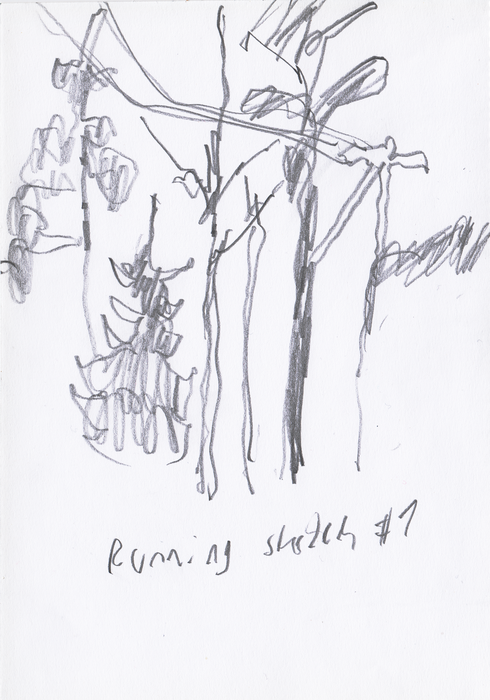Running sketch from March 2016. Pencil on A5 notebook paper. The swirling road becomes the central motif around which the impressions are collected.
Above: Two running sketches from the session of March 2016. Pencil on A5 notebook paper. The first focus is on the repetitive roadside, collecting elements in a linear way as they fit on the paper. From the outcome there is no way to know if the elements (trees, streetlights) are taken from a single viewpoint or are an assemblage.
RUNNING SKETCH
Run with the sketchbook in your hand and try to include what you see into the current drawing. At the same time the drawing ought to be fast, each drawing should last only a few minutes. It can be helpful if the area is previously unknown to you.
Running provides a physical condition that makes the basic trace making more challenging.
Interspersing the running sketches with walking and static sketches can be helpful in gauging the difficulty of the task and the amount of detail that can be fit in a single drawing. It is possible that the location needs a specific approach to make the images work.
Aims:
1. Question the idea that a drawing from life is a determined vista or an optical snapshot from a specific point. The result is a composite of observations and impressions.
2. Develop a drawing approach that is particular to the motif or site.
3. Shatter the reliance on a stable line and accuracy. Drawing can be made to involve other things than the tip of the pen and the mind.
Further reflection:
The Running Sketch exercise was initiated in a design school course of Design Exploration and Experimentation (see Kosonen & Mäkelä 2012) where I was a co-teacher in early 2016. A portion of the course took place in Koli, Finland. Students worked on themes of place and space. This environment for making rapid small tasks inspired me to examine my drawing work in terms of a place-specific task.
To me, the first running sketches invited further elaboration. The exercise needed the idea that a more specific motif would be useful for the sketch, which here is the swirling road.
It would be possible to make the picture elements overlap or detach them from each other, as in futurism or cubism. However, as an exercise I feel for my goal-setting a more conventional landscape was a better target.
In a later walking sketch, it became possible to build a more articulate landscape, albeit less raw than the running sketches. March 2016. Pencil on A5 notebook paper.






